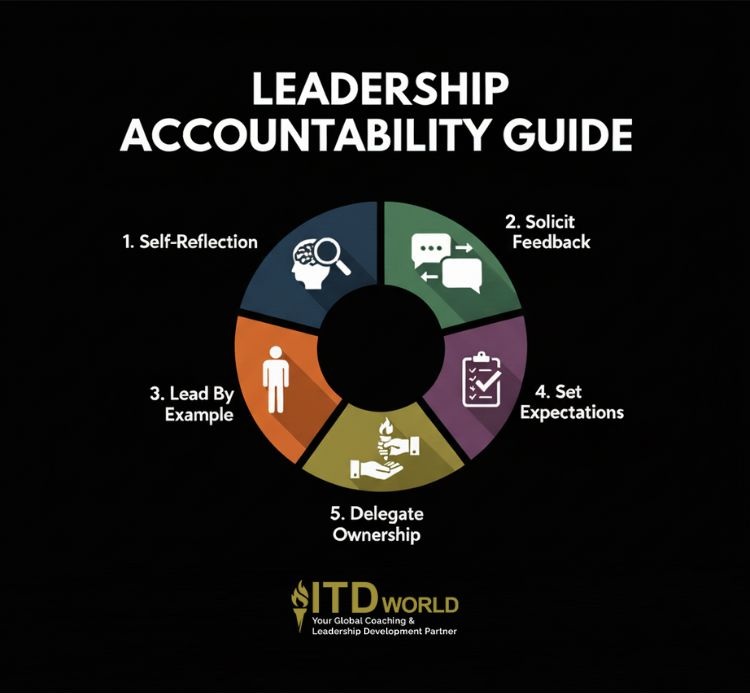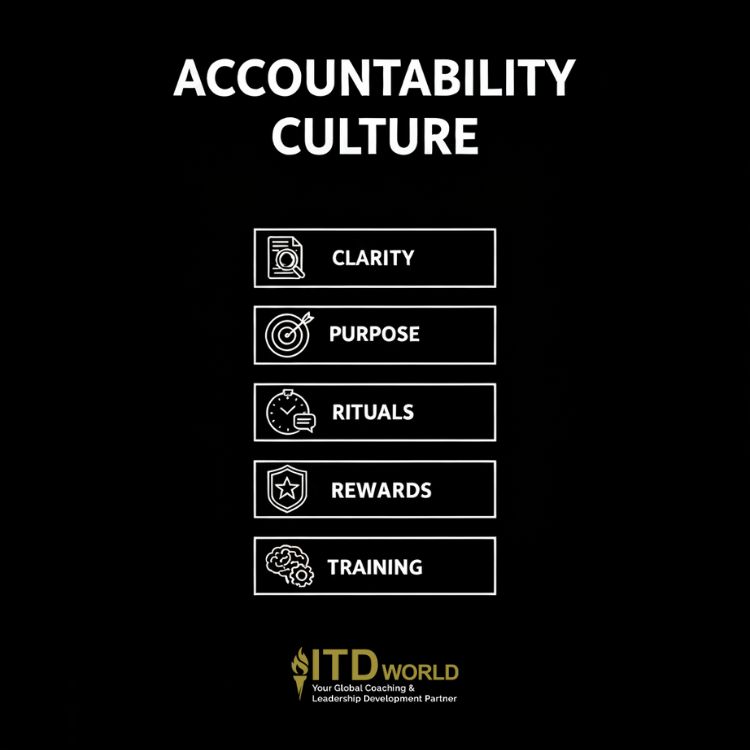Learn what leadership accountability looks like, its importance for business success, plus steps for putting it into practice.
As the saying goes, “Accountability is the glue that ties commitment to results.” In any organization, it is the essential ingredient that transforms plans into achievements – and promises into reality. True leadership accountability is not a punitive system of blame; it involves a proactive commitment to ownership that fosters a culture of high performance, empowering teams to deliver on their goals with integrity and purpose.
|
Author: Jonathan M. Pham |
Highlights
- Leadership accountability is when leaders take full personal ownership for their actions, commitments, and outcomes, focusing on solutions and learning rather than assigning blame, thereby fostering trust, clear expectations, and psychological safety within their teams.
- As outlined in “The Oz Principle”, leadership accountability involves a four-step framework – See It, Own It, Solve It, Do It. It empowers leaders to move beyond blame and excuses to proactively address challenges by recognizing facts, accepting personal responsibility, identifying solutions, and taking decisive action.
- To practice accountability, leaders should engage in rigorous self-reflection, actively solicit feedback to address blind spots, lead by example, set crystal-clear expectations, and delegate ownership of results, not just tasks.
- Building an accountability culture requires senior leadership and HR to collaborate in “hardwiring” ownership into the organization by establishing clarity, fostering a shared purpose, implementing accountability rituals, aligning recognition and consequences, and investing in leadership training.
- Effective leaders master compassionate accountability, which means they are able to balance firmness with empathy; they achieve this by being tough on the problem while being supportive of the person, fostering growth and trust without resorting to blame or fear.
What is Leadership Accountability?
Leadership accountability is the practice of leaders taking complete, personal ownership for their actions, commitments, and the resulting outcomes – both good and bad. It represents a fundamental shift in focus from simply reporting on activity to answering for the results.
Crucially, it is NOT about finding fault. True accountability is a forward-looking commitment to learning and improvement, not a backward-looking search for a scapegoat. It is the core discipline that allows trust to flourish and inspires teams to perform at their best.
Key Characteristics of Leadership Accountability
An accountable leader is someone who consistently demonstrates:
- Unwavering integrity: Their actions are always aligned with their words. They do what they say they will do.
- A focus on solutions, not blame: When a problem arises, their energy immediately goes toward devising a solution and learning from the situation, not pinpointing who was at fault.
- A willingness to take responsibility: They are often the first to say, “I made a mistake,” or “I own this outcome,” especially when things go wrong. As such, they demonstrate a powerful example for the entire team.

As such, their behavior plays a crucial role in cultivating a positive corporate environment characterized by:
- High levels of trust: Team members trust that their leaders and colleagues will follow through on their commitments and will treat errors as learning opportunities.
- Clarity of expectations: Roles, responsibilities, and what success looks like are clearly defined and understood by everyone, eliminating confusion.
- Psychological safety: There is a shared understanding that it is safe to take smart risks, to admit wrongdoings early, and to be transparent about challenges without fear of punishment.
Example: In a culture of blame, if a team misses a sales target, the first question is, “Whose fault is this?” In an accountable culture, the leader says, “We didn’t hit our number, and I own that result. Let’s analyze the data together to figure out what we can learn and what our new plan will be to succeed next quarter.”

Integrity and accountability in leadership
Why is Leadership Accountability Important?
- Builds long-lasting trust
Trust is the currency of modern business; according to the 2025 Edelman Trust Barometer, employees who believe in their leadership are significantly more engaged, loyal, and committed to the organization’s success. Accountability is how that trust is earned. When leaders take ownership of their commitments and outcomes, they contribute to establishing an environment of psychological safety and prove their reliability.
- Drives performance
Accountability is the engine of execution; it eliminates ambiguity, clarifies expectations, and motivates teams by giving them clear ownership over their goals. Research from consulting firms like McKinsey & Company has shown that organizations with a strong “ownership mindset” or accountability culture exhibit both faster growth and higher profitability than their peers.
- Prevents a toxic “blame culture”
A lack of leadership accountability creates a vacuum that is quickly filled by a toxic culture of finger-pointing, excuse-making, and hidden problems. When leaders fail to take ownership, they essentially model the behavior that it is acceptable to blame others. This erodes collaboration and prevents the organization from learning from its mistakes, leading to repeated failures and low morale.
Read more: Weak Leadership – How Bad Leaders Undermine Success
Real-life Example of Accountability: The Turnaround at Ford
A legendary example of accountability transforming a business is Alan Mulally’s tenure as CEO of Ford, beginning in 2006. He inherited a deeply dysfunctional culture of silos and blame, where leaders would hide problems rather than admit failure.
At his weekly Business Plan Review meetings, leaders would present charts showing the status of their projects. Initially, every chart was “green,” even as the company was losing billions. Mulally knew this was impossible. The turning point came when one brave executive, Mark Fields, finally presented a chart with a “red” status for a major product launch that was facing delays.
Instead of reprimanding him, Mulally began to applaud, saying, “Thank you for the transparency. Now, what can we do to help you?”
That single act of rewarding accountability over punishing failure shattered the culture of fear. People realized that it was safe to be honest about problems; as such, the entire leadership team rallied together and tried to solve them collaboratively. This shift to a culture of total accountability was instrumental in Ford’s historic turnaround, allowing it to avoid the bankruptcy that befell its major US rivals.
TED Talk leadership accountability video
Components of Leadership Accountability: A Framework for Action
To practice accountability consistently, leaders need more than just good intentions – they need a practical framework. One of the most widely recognized models comes from the bestselling book, “The Oz Principle“; it provides a simple yet powerful path for individuals and teams to move from a passive mindset of blame and excuses to a proactive state of ownership and action.

(Source: ResearchGate)
The core idea is to operate “Above The Line,” where one actively chooses accountability, rather than falling “Below The Line” into a cycle of victimhood and finger-pointing. This journey is broken down into four steps. Here, we will illustrate these steps with a common business scenario: A critical project is behind schedule due to an unexpected technical issue with a vendor’s software.
- See it: Recognizing the facts of the situation without denial, sugar-coating, or avoidance. It’s about seeing things as they are, not as you wish they were.
Example: An accountable leader may call a meeting and state the facts clearly: “Team, let’s be honest about where we are. We are two weeks behind schedule on Project X because of the integration issue with the vendor’s software.”
- Own it: Accepting personal ownership for one’s role in the situation and its outcomes, regardless of external factors. It requires shifting your focus from what others have done to you to what you can do.
Example: “While the vendor issue was a contributing factor, I am ultimately responsible for this project’s timeline. I own this delay. I should have built in more contingency time for integration risks.”
- Solve it: Moving beyond acknowledging the problem to actively identifying solutions. It involves fostering creativity, collaboration, and a relentless focus on what can be done to move forward.
Example: Instead of waiting someone else to fix the problem, one may facilitate a brainstorming session: “Now that we own this problem, what are our options? Can we work with the vendor on a patch? Can we develop a temporary workaround? What resources do we need to get back on track?”
- Do it: Taking decisive action and following through on the agreed solutions with diligence and commitment until the desired result is achieved.
Example: “Okay, we’ve decided on the workaround. Sarah, you will lead that sub-team. I will personally call the vendor’s CTO to escalate the issue. Let’s have a quick check-in every morning at 9 AM to track our progress until we are back on schedule.”
Leadership accountability model
Read more: Leadership Journey – How to Grow as a Leader at Every Stage
How to Practice Accountability as a Leader
-
Practice rigorous self-reflection
Accountability begins with an honest internal dialogue. Before you can answer to others, you must first asnwer to yourself. This means regularly taking time to assess your own actions, decisions, and their impact without bias.
In practice: At the end of each week, try scheduling just 15 minutes to ask yourself: “Did I follow through on all my commitments this week? Where did I fall short? What was my role in the team’s successes and setbacks?” A simple practice, yet it is enough to build the self-awareness muscle needed for public accountability.
Read more: Why Follow Up Matters in Behavior Change & Leadership
-
Actively solicit feedback
As hard as one reflects on themselves, there may still be certain blind spots that they are not aware of. As such, aspiring accountable leaders should demonstrate the courage to seek external perspectives to see themselves as others see them (which is a key part of the “See It” step).
In practice: Don’t wait for the annual performance review. Try asking direct questions of trusted colleagues after a key interaction, such as, “In the project meeting yesterday, what was the impact of my approach when I challenged the data? What could I have done differently?”
Read more: Continuous Feedback – A Cornerstone of Modern Workplace
-
Lead by example
This is the most powerful way to demonstrate accountability. A leader must be the first to take ownership, especially when things go wrong.
In practice: When a project deadline is missed, start the conversation with something like, “I am responsible for this team’s output, so ultimately, this delay is on me. Let’s talk about what happened so I can understand what support I could have provided.” Doing so immediately de-escalates blame and directs the team’s focus onto solving the problem.
-
Set crystal-clear expectations
You cannot hold people liable for expectations that were never clearly set. As leaders, your job is to work tirelessly to eliminate ambiguity for the teams.
In practice: Consider leveraging frameworks like OKRs (Objectives and Key Results) or even a simple, shared project plan to define exactly what success looks like, who is responsible for each component, and by when. Such clarity is a prerequisite for fair and effective accountability.
-
Delegate ownership, not just tasks
Instead of assigning a to-do list (which keeps you as the owner), entrust your team members with responsibility for a result.
In practice: Rather than saying, “Please complete tasks A, B, and C for the client report,” one should say, “You are accountable for delivering a successful client report by Friday. You have my full support. What do you need from me to make that happen?”
Read more: 12 Golden Leadership Principles for Attaining Excellence

How to demonstrate accountability to others
Building an Accountability Culture
While individual leaders set the tone, a culture of accountability is only sustainable when it is “hardwired” into the organization’s operating system. Senior leadership and HR must work together to build the systems, processes, and cultural norms that make ownership the default, not the exception.
-
Build a foundation of clarity
Accountability cannot exist in a state of ambiguity. It is crucial that the organization set up systems and tools that make responsibilities, goals, and deadlines crystal clear to everyone.
In practice: For key projects, implement simple but powerful tools like a RACI chart to define who is Responsible, Accountable, Consulted, and Informed. Invest in transparent project management and communication systems where goals and progress are visible to all stakeholders – so as to eliminate the common excuse of, “I didn’t know that was my job.”
-
Foster a strong sense of shared purpose
People are far more likely to take ownership of their work when they believe it is connected to a meaningful mission. Accountability thrives when individuals feel they are contributing to something larger than themselves.
In practice: Senior leadership must constantly communicate the organization’s “why” – by regularly connecting departmental initiatives and even individual goals back to the company’s overarching mission, so that everyone is well aware of how their specific contribution moves the entire business forward.
Read more: Spiritual Leadership – A Remedy for Today’s Workplace Woes
-
Implement accountability rituals
Embed accountability into the regular cadence of the business by establishing consistent team-based rituals focused on learning and ownership.
Example: Make After-Action Reviews (AARs) a standard procedure after every major project or initiative. The goal of an AAR is to review results without blame by addressing four simple questions:
- “What was supposed to happen?”
- “What actually happened?”
- “Why was there a difference?”, and
- “What will we do differently next time?”
-
Align recognition and consequences
The principle that “what gets rewarded gets repeated” is the cornerstone of culture change. Your organization’s formal systems must reinforce and reward accountable behavior.
In practice: Ensure that performance reviews, promotions, and bonus allocations consistently recognize and reward individuals and teams who take ownership and deliver on their commitments. A lack of accountability must also have clear, fair, and consistent consequences. When such an alignment exists, the culture of ownership strengthens itself.
Read more: Organizational Transformation – An Essential Guide to Successful Implementation
-
Invest in leadership training
You cannot expect leaders to be masters of holding others accountable without teaching them how to do it effectively and compassionately.
In practice: Invest in leadership development programs that specifically teach skills like setting clear expectations, giving constructive feedback, and holding difficult conversations. Furthermore, providing one-on-one coaching is one of the most effective ways to help leaders build their own personal sense of accountability and learn how to foster it in their teams.
Read more: Leadership Excellence – Moving From Manager to Multiplier

Leadership accountability activities
The Challenge of Balancing Accountability and Compassion in Leadership
One of the most significant challenges for modern leaders is navigating the apparent paradox between driving accountability and leading with compassion. The fear of being seen as “too soft” can cause some leaders to become rigid and unforgiving, while the fear of being seen as “too harsh” make others avoid difficult conversations entirely.
When a culture is high on accountability but low on compassion, accountability can be “weaponized.” It ceases to be about ownership and improvement and instead becomes a tool for assigning blame, punishing failure, and creating a culture of fear. The result? Employees become risk-averse. They are afraid to innovate, hesitant to admit mistakes, and more focused on protecting themselves than on collaborative problem-solving – which ultimately stifles growth and leads to team burnout.
The most effective leaders are those who practice what can be called compassionate accountability. They understand that holding someone accountable is, in fact, an act of compassion – it shows that you care enough about that person’s growth and the team’s success to have a difficult but necessary conversation. The core principle is simple but powerful: be hard on the problem, but soft on the person.
This approach separates the individual’s value and potential from their performance on a specific task. It holds them to a high standard while reinforcing that you are there to support them.
Example in action:
Imagine a team member fails to deliver their part of a critical project, impacting the entire team’s timeline.
An unbalanced leader might lead with blame: “You missed the deadline, and now the whole team is behind.”
On the other hand, a leader practicing compassionate accountability would schedule a private conversation and start with a focus on shared ownership and future success:
- Own it together: “Let’s talk about the project deadline. We didn’t hit our target, and we need to own that result together.”
- Inquire with compassion: “Please help me understand what happened. What obstacles did you run into? What support did you need that you might not have received?”
- Re-commit to success: “I am committed to your success on this team. Let’s come up with a clear plan to get this back on track, and more importantly, let’s discuss how we can prevent these obstacles from happening again in the future.”
Read more: Ego in the Workplace – The Hidden ‘Evil’ Behind Team Dysfunctions

Leadership accountability in the workplace
Leadership Accountability Quotes
Check out more accountability quotes here!
Without accountability, there can be no trust, and without trust, there can be no meaningful collaboration.
Patrick Lencioni
Accountability breeds response-ability.
Stephen R. Covey
The price of greatness is responsibility.
Winston Churchill
Real integrity is doing the right thing, knowing that nobody’s going to know whether you did it or not.
Oprah Winfrey
The culture of any organization is shaped by the worst behavior the leader is willing to tolerate.
Gruenter and Whitaker
Leaders inspire accountability through their ability to accept responsibility before they place blame.
Courtney Lynch
You are responsible for the choices you make.
Joel Osteen
Trust is built with consistency.
Lincoln Chafee
Mistakes are always forgivable, if one has the courage to admit them.
Bruce Lee
Leadership Accountability Books
- 📘 Accountability Leadership by Di Worrall
Focus: Building a high-performance culture of accountability
Highlights:
-Presents a practical framework for transforming accountability from a punitive concept into a positive force for change
-Includes real-world case studies and actionable strategies for leaders to inspire follow-through and ownership
-Emphasizes feedback, feed-forward, and follow-through as key tools for sustaining performance
- 📗 Accountable Leaders by Vince Molinaro
Focus: Creating a culture where everyone steps up and delivers results
Highlights:
-Provides a blueprint for scaling leadership accountability across organizations
-Identifies five attributes of accountable leaders and five key drivers of leadership culture
-Includes diagnostic tools and strategies for closing leadership gaps and cultivating strong teams
- 📙 Community of Leaders by Vince Molinaro
Focus: Driving strategy, culture, and change through leadership collaboration
Highlights:
-Expands on Molinaro’s previous work by emphasizing shared accountability among leadership teams
-Introduces 10 characteristics of a strong leadership community, such as united front, resilience, and mutual support
-Offers tools to build trust, break silos, and foster strategic alignment
- 📘 Crucial Accountability by Kerry Patterson et al.
Focus: Resolving broken commitments and bad behavior
Highlights:
-Offers tools for holding others accountable in a respectful, non-confrontational way
-Builds on the Crucial Conversations framework to improve team dynamics and trust
-Ideal for leaders navigating difficult conversations
- 📗 Accountability: The Key to Driving a High-Performance Culture by Greg Bustin
Focus: Linking values, strategy, and execution
Highlights:
-Introduces the CULTURE framework for building accountability
-Based on interviews with top-performing CEOs and leadership teams
-Helps leaders align personal values with organizational goals
Read more: Leadership Values – 10 Qualities for Exceptional Results

How Coaching Drives Leadership Accountability
The ability to hold people accountable with compassion is one of the most sophisticated and impactful skills a modern leader can possess. It is something cultivated through deep self-awareness, a structured framework, and dedicated practice. Professional coaching is one of the most powerful methodologies for promoting this exact capability in your management team.
At ITD World, we are global leaders in coaching and leadership development, with a specific focus on programs that equip leaders to drive both performance and a positive, high-ownership culture. Our solutions are designed to help your leaders master the art of compassionate accountability:
- Executive coaching: We provide a confidential and challenging space for your executive leaders to cultivate their own personal sense of ownership. Our expert coaches help them develop the skills and confidence needed to conduct accountability conversations with their teams.
- Certified Coaching & Mentoring Professional (CCMP): Our flagship certification program equips participants with the core competencies of professional coaching, enabling them to foster a culture of ownership and continuous development from within.
- Customized in-house solutions: We partner with you to design bespoke programs tailored to your unique challenges and strategic goals.
Ready to build a culture of ownership that drives exceptional results? Contact ITD World today to learn how our world-class training solutions can help!
Other resources you might be interested in:
- 5Cs of Effective Accountability Partners
- Servant Leadership: A Transformative Management Philosophy
- Leadership Philosophy: How to Define Your True North & Follow It
- Transformational Leadership: Inspiring Change & Growth

